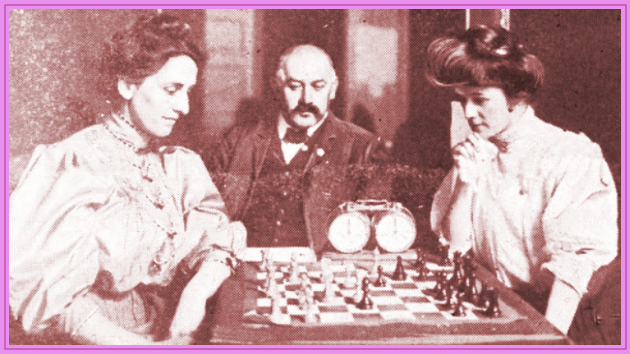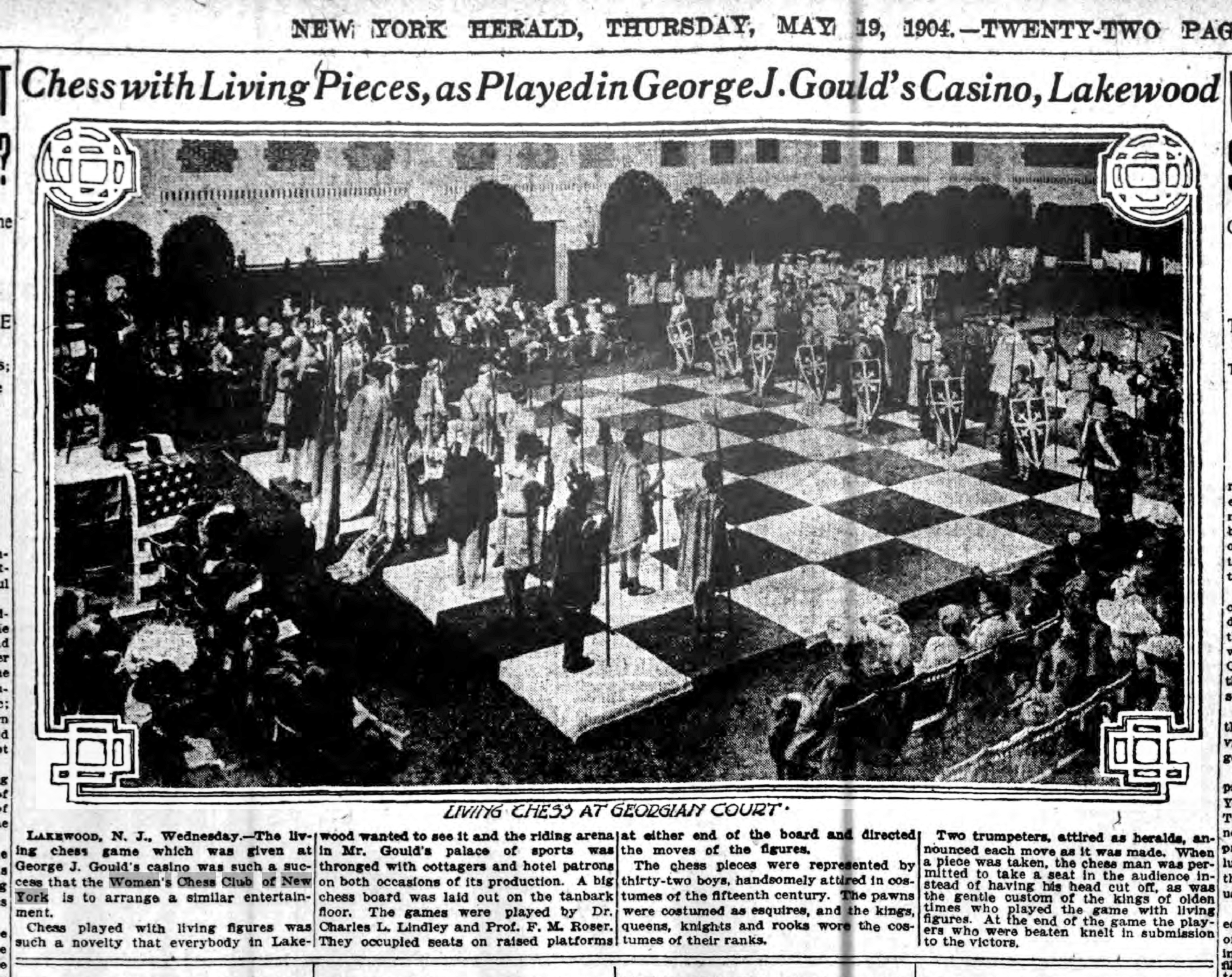
The Women's Chess Club of New York
The famous Ladies' Chess Club of London was organized at their first meeting on January 14, 1895.
Predating that monumental event was the creation of the Women's Chess Club of New York.
In 1893 a small group of women who were meeting at Eliza C. Foot's apartment at 28 East 22nd st. in Manhattan to play chess decided to organize something more formal. This group, which called itself the Women's Chess Association of America,
from ""Women in Chess," an article from The New York Times, Sept 1, 1895
"America has for several years had such an organization, its members holding weekly meetings during seven months of the year. In the Spring of 1893 a few women met informally and organized what is now known as the "Women's Chess Association of America," their plan of organization being closely allied to that of the Manhattan Chess Club of New-York. In January, 1894, they elected their officers, and since that date they have had their weekly meetings at the Ladies' Club, 28 East Twenty-Second Street. Their roll of membership is at present seventy-five, including a number of honorary members selected from among the best women players in England and Ireland, the champion player of England, Miss Mary Rudge, and Mrs. Rowland of Ireland being among the number. For three years a game has been in progress between Mrs. Rowland and a member of the American Association, and the issue is still uncertain. During the coming Autumn, Winter, and Spring months the New York members of the association will hold their weekly meetings in the spacious quarters of the woman's Headquarters, 50 West Fifty-fifth Street."
met in early January 1894 and elected officers. It would be another 2 years before this association would become incorporated, but on December 17, 1895 Eliza C. Foot, Jean L. Nesbit, E. Somers Haines, Sophie Downer and Susan A. R. Parker exectuted the Certificate of Incorporation, signed by Hermann Borchert, Commissioner of Deeds and Geo. P. Andrews, Justice of the N.Y. Supreme Court, the given date of organization of the entity being noted as January 6th, 1894 (1 year before their London cousin).

The constitution, published in 1897, states the official name of the organization would be the Women's Chess Club of New York and at the time 32 regular (dues-paying) members and 14 honorary members were instated:
MEMBERS:
Mrs. George Huntington Adams, Miss M. Adele Barrow, Mrs. Isaac R. Cornell, Miss Emma De Coursey, Miss Sophie Downer, Miss Mary Drake, Miss Julia T. Eidlitz, Miss Eliza Campbell Foot, Miss Sadie Bard Haight, Mrs. William A. Haines, Sr., Miss Emily Somers Haines, Mrs. Woolsey R. Hopkins, Mrs. Woolsey Hopkins, Mrs. John Henry Hubbell, Mrs. Daniel Moran, Mrs. Winthrop Parker, Miss Alice J. G. Perkins, Miss Frances Peters, Miss Elizabeth Haines Sabine, Mrs. William Hamilton Stockwell, Miss Ella Church Strobell, Miss Mary Gabriella Titus, Miss Eliza R. Tompkins, Mrs. Eliphalet Williams Tyler, Miss Tweedie, Mrs. William Gordon Ver Planck, Mrs. William Minavar VerPlanck, Miss Mina G. Waterbury, Mrs. Benjamin C. Webster, Mrs. William G. Weld, Mrs. Ferdinand Wiechmann, Miss Clementine Yates.
HONORARY MEMBERS.
Miss Jean L. Nesbit and Miss Edith Schieffelin Sabine,
FOREIGN HONORARY MEMBERS.
Mrs. Sterling Berry, Dublin, Ireland.
Miss Brown, Clontarf, Ireland.
Miss J. Brown, Clontarf, Ireland.
Miss Craig, Clontarf, Ireland.
Mrs. Studdert Kennedy, Dublin, Ireland.
Miss Lynam, Clontarf, Ireland.
Miss Oldpield, Dublin, Ireland.
Miss Patterson, Belfast, Ireland.
Mrs. T. B. Rowland, Kingstown, Ireland.
Miss Frideswide Annie Beechey Rowland, Kingstown, Ireland.
Miss Mary Rudge, Bristol, England.
Miss Varian, Clontarf, Ireland.
Directors were chosen: Mrs. Benjamin C. Webster, Mrs. William Hamilton Stockwell, Mrs. Daniel Moran, Miss Eliza Campbell Foot, Mrs. Winthrop Parker, Mrs. William Gordon Veb Planck, Miss Sophie Downer, Mrs. William Minavar Ver Planck and Miss Emily Somers Haines. The directors installed the following officers: Miss Eliza Campbell Foot, President. Mrs. Wintheop Parker, Vice-President. Miss Emily Somers Haines, Secretary. Miss Sophie Downer, Treasurer.
The initial headquarters would be in Miss Foot's new apartment at 50 West 55th st. The N.Y. Tribune, March 1, 1896 notes that chess master Major James Hanham of the Manhattan C.C.. frequented the Ladies' Club, playing simuls of "five or more opponents." In 1897 the club started meeting in "the handsome club-room" of the Town and Country Club at 12 E. 22nd st. where 7 tables could be set up and were almost always full. In 1898, however, the headquarters was moved to the Carnegie Building (Carnegie Hall) at Seventh avenue and Fifty-sixth street. This located must have been somewhat suitable since the club met there for at least six years.
The Hotel Martha Washington was completed on March 2, 1903. According to the N.Y. Tribune, Nov. 27, 1905, the club was by then meeting in the parlors of that hotel. This was possibly already the home of Eliza Foot -she is known to have been living there for sure in 1909 but no records of her address for the several years prior seem readily available. The American Chess Bulletin gives her address in 1907 and 1908 as the Laurel House of Lakewood, N.J. but the Laurel House was only a winter resort, opened from October to June. Miss Foot may have benefited from the milder climate the Lakewood area offered. The chess season also ran a similar span and it's 75 miles from Lakewood, N.J. to Manhattan.
 Laurel House ad from 1904
Laurel House ad from 1904
The Hotel Martha Washington would enjoy a long history with women's chess in New York. As a women-only hotel - the first one in New York dedicated solely to women - and moderately priced, it was the ideal venue.

I've seen it mentioned that Nellie Showalter and Harriet Worrall, ladies who vied for the women's chess championship of the United States in 1894, were members of the Women's Club, but I could find no documentation (other than possibly Worrall's inclusion in the photo of the founders at the end of this article) supporting this. Worrall took part in the 1897 Women's International Chess Congress. Showalter was also invited but couldn't go and Eliza Foot was Worral's substitute had she been unable to attend, so there is a chess connection.
According to Woman's Who's Who of America by John William Leonard, 1914, Eliza Campbell Foot, born in Geneva, N.Y. on Feb. 23, 1851 was the daughter of Samuel and Jane (née Campbell) Foot. She would have been the youngest of 7 children. Samuel Alfred Foot was an eminent N.Y. Lawyer known for his extensive collection of Duncan Phyfe furniture. Jane Campbell was his second wife.

Miss E. C. Foot was the prime impetus for the creation and growth of the Women's Chess Club of New York. According to Libby Lackman in the N. Y. Times Jan. 5, 1941, "in order to swell the membership, she [Miss Foot] took it upon herself not only to persuade non-chess players to learn the game but taught them herself."
The American Chess Bulletin, May/June 1949 added:

She served as president from its inception until her death from a hit-and-run driver in 1914. Coincidentally, in 1931 her counterpart, Rhoda Annie Bowles, the founder of the Ladies' Chess Club of London, also died in an auto accident.
The fact that she sometimes lived in Lakewood, N.J. probably had something to do with the following event:
Miss Foot was known to tutor chess, along with Dr. Charles L. Lindley, at the boy's home. In 1904 Dr. Lindley with the assistance of Miss Foot arranged and directed a well publicized Living Chess game on the grounds of the Georgian Court, George J. Gould's estate in Lakewood. Gould himself was an ardent chess player which possibly made him amenable to the staging of the event. (for greater detail see: https://www.chess.com/blog/batgirl/unbridled-opulence )

(view full size) (original drawing)
In 1957 Julia Paul Harper, then president of the club, wrote a very concise history for Chess Review. She mentions that Miss Foot was responsible for the cast of characters for the living chess show at Georgian Court.
The American Chess Bulletin, May/June 1949 tells us additionally:

In 1906 The Women's Chess Club of New York, along with Isaac L. Rice, sponsored the 1st American women's chess congress. Taking place, of course, in the Hotel Martha Washington, it was comprised of two tournaments.with 6 participants in the general tournament and 3 in the championship tournament. Mr. Rice was the president and Miss Foot was the vice-president of the event.

The championship tournament included Mrs. Charles P. Frey (née Mary Grace Rogers) of Newark, N.J., Mrs. Frank Wallace Lynn (née Anna Belle Barnes) of Chicago, Ill. and Mrs. M. Wilkinson-Robertshaw of New York City.
The general tournament included Mrs. E. H. Burgess (not to be confused with S. R. Burgess) of Long Island, Eliza Foot of Lakewood, N.J, , Mrs. Charles H. Stoddard of New York, , Mrs. Winthrop Parker of New York and Mrs. Eliphalet Tyler of New York and Miss Myldrede L. Walker of Brooklyn.
 Mrs. Frank W. Lynn
Mrs. Frank W. Lynn
(cropped from Chicago Daily News negatives collection, Chicago History Museum
via http://chessreader.blogspot.com/2012/10/)
Mrs Frank Wallace Lynn of Chicago was popularly considered the best active woman player of the day and was expected to win the championship tournament.

The championship tournament (effectively the U.S. women's title), however, was won by Mrs. Charles Percival Frey.

Mrs. Wilkinson-Robertshaw was clearly out of her depth but was commended on her fighting spirit nonetheless.
 Mrs. Lynn vs. Mrs. Wilkinson-Robertshaw
Mrs. Lynn vs. Mrs. Wilkinson-Robertshaw
The American Chess Bulletin (edited by Hermann Helms and Hartwig Cassel) published the following two games (I want to recognize David Moody -"Phony Benoni" on chessgames.com for his massive effort digitizing games from entire issues of the ACB, making my own burden much lighter. Mr. Moody also generously provided me with all the information used in this article from the American Chess Bulletin, May/June 1949 ):
Mrs. Lynn, who came into prominence in 1902 after beating Em. Lasker in a simul game even though she had never played other than with friends or family, belonged to an elite group of women, true even today, but more so at the start of last century: women chess columnists. Mrs. Lynn edited a column for the Chicago Tribune for a few months. Other, more entrenched columnists include Rhoda A. Bowles who edited a column for Ada Ballin's Womanhood magazine during its 8 years in existence and Rosa Jefferson who had a column in the Memphis' The Commercial Appeal for nearly 30 years. Frideswide Beechey edited an unattributed chess column for an indefinite time for the Sheffield & Rotherham Independent of South Yorkshire.
The general tournament was won by Mrs. E. H. Burgess with a perfect score. Mrs. Burgess was a member of the Women's Chess Club of New York as well as sister of Frederick Burgess, Bishop of the Episcopal Diocese of Long Island.
Brooklyn Life, May 19, 1906 noted:
"The success of Miss Burgess can probably be attributed to the advantage she has enjoyed from practice with her brother, the Bishop, who is an enthusiast over the game and accounted a very strong player, though he has-been known to say that it had sometimes occasioned him, a sleepless night: since it is certainly the most absorbing of games, it is a question whether it is beneficial to those whose occupations call for a large expenditure of brain energy. On the other hand, it is a grand recourse when one is hard beset by trouble or anxiety, since it is impossible to play it without becoming temporarily oblivious of all but the problems before one."

The winners of each tournament (Mrs. Frey and Mrs. Burgess) were presented with a solid gold medal appraised at $50.
Ironically and tragically, Mrs. Burgess died just shortly after her victory:
 American Chess Bulletin, June 1906
American Chess Bulletin, June 1906
Mrs. Winthrop Parker took ill during the tournament and was forced to drop out, forfeiting most of her games. She did come back the next year to win the club championship:
Woman's Chess Club of New York.
At an enjoyable tea held by the Woman's Chess Club at the Hotel Martha Washington on the afternoon of May 7, the championship tournament of that thriving organization was brought to a conclusion, with Mrs. Winthrop Parker of New York City the winner. She received a chess pin in the form of a gold knight. Second prize was awarded to Miss Eliza Campbell Foot, of Lakewood, N. J., who received a chess pin in the form of a rook. Mrs. William Gordon Ver Planck, the treasurer, made the presentations. Fourteen players competed in the event. After the formal award had been made, a presentation of flowers by Miss Foot, Mrs. Parker, Mrs. Ver Planck and Miss E. Somers Haines took place. Miss Haines, the secretary, states that eighteen new members had been received into the ranks during the past year, and that the prospects of future success are exceedingly bright.
-- American Chess Bulletin, May 1907 1907
Also in 1907 while in Brooklyn with he husband, timed partly to observe the Anglo-American cable match on Feb. 22-23, Mrs. S. R. Burgess of St. Louis took the opportunity to challenge Mrs. Frey to a title match. Their spouses arranged the terms and the match started fairly quickly. This match, played at the Hotel Martha Washington from March 2-9 and refereed by Prof. Rice, was the first time Mrs. Burgess played using a clock. That fact didn't prevent her from winning convincingly +4=1-1. Other than one French Defense, all the games were Queen Gambit Declined.
Below is the first game, the French Defense and the only one won by Mary Grace Frey; and the third game, won by Eveline Burgess and deemed the best of the match.
While Mrs. S. R. Burgess (1856-1936) lived a lot longer than Mrs. E. H. Burgess, Mrs. Charles P. Frey died rather young just a few years after this contest.
 Mrs. Samuel Rostron Burgess (née Eveline Allen)
Mrs. Samuel Rostron Burgess (née Eveline Allen)
Before leaving for St. Louis Mrs. Burgess expressed that she was open to play any future challenger. In 1908 there was a response. Learning that Mrs. S.R. Burgess, the women's chess champion, would be in New York, Mrs. Charles Edward Nixdorff, then of Cambridge, Mass., hurried to the city to make a formal challenge. The challenge and terms settled upon on Feb. 18 (by their husbands), the match was scheduled to start Feb. 20 (it lasted until the 25th) Once again the match, of 5 games total, was played at the Hotel Martha Washington with Isaac Rice refereeing and consisted of 2 French Defenses and 3 QGD. And once again, Mrs. Burgess won convincingly +4-1. Mrs. Burgess won a gold medal.
Here is Mrs. Nixdorff's only win:
the first game of the match:
the January 1910 issue of the American Chess Bulletin announced the death of one of its stalwart members, Mrs. Winthrop Parker:

Sadly, the death of the newly-appointed director, Mrs. Frey, was reported just 2 months later:
 American Chess Bulletin, March 1910
American Chess Bulletin, March 1910
The previous year it was reported that Miss Eliza Foot had published a series of chess problems:

It's not clear if this refers to the same thing, but the timing makes it seem likely that the publication wasn't a book (of which there is no trace anyway) but postcards:
 N.Y. Sun, Nov. 21, 1909
N.Y. Sun, Nov. 21, 1909
A second Women's Chess congress was in the works when tragedy struck:

American Chess Bulletin, May/June 1956
Miss Eliza Foot's unexpected death on Dec. 6, 1914 was a severe blow to the organization. Strangely, the American Chess Bulletin seems to have no mention of her passing in any of the 1915 issues. However in 1916 a new president was noted:

Noted as well is the ascendancy of Natalie Nixdorff who won her first of numerous club championships (I counted 9) and a small tribute to Miss Foot:

In 1918 the club started meeting at the Manhattan Chess Cub on Friday afternoons.
A new president emerged in 1919, Miss Emily Somers Haines:

The 2nd American Women's Chess Congress took place in 1921 in conjunction with the 8th American Chess Congress played on the Million Dollar Pier in Atlantic City from July 6-20. There were 4 entrants in the Women's Championship: Mrs. Nixdorff, Marjorie Seaman of Staten Island, Mrs. Arthur C. Forbes of Brooklyn and Mrs. Frances von Haebler of Philadelphia. Mrs. Haebler never actually attended however. Miss Nixdorff won the event easily:
 . . .
. . . 
Here is a murky cropped portion from a group-shot taken at the 8th American Chess Congress:

The 4 ladies in the back L-R: Hermann Helm's daughter Thelma, Marjorie Seaman, Mrs. Hermann Helms and Natalie Nixdorff
(the 3 men L-R are Hermann Helms, Dr. V. S. Hayward and Frank Marshall)
Natalie Nixdorff, née Meysenburg, was born Germany in 1853. Her family moved to St. Louis when she was 2 years old. She had 8 brothers and 4 sisters. Her father, F. W. Meysenburg, taught all his boys to play chess but Natalie was the only girl who took an interest in the game. Het brother, T. A Meysenburg, organized the chess club at the St. Louis Mercantile Library. Her brother, Edward A. Meysenburg, was president of the Providence Chess club and another bother, Emil, was a member of the Brooklyn Institute of Arts and Science Chess Club. Miss Nixdorff died in late December, 1936.

Mrs. W. I. Seaman was born Marjorie Luce in Boston either in 1881 (NYTimes obituary) or in 1889 (Luce family genealogy page). On October 20, 1905, she married William Iucho Seaman of Staten Island, N.Y. She was both a chess and bridge player who, besides winning eleven championships of the Women's Chess Club of New York. was a member of the Correspondence Chess League, the Marshall Chess Club, the Staten Island Chess Club and, of course, the Women's Chess Club of New York. According to Julia Paul Harper (Harper's article can be read in full here) "In 1946 she organized a chess class for boys and gave weekly chess classed for disabled veterans" and was "honored as one of the most distinguished and energetic workers n the cause of chess and the Women's Club." She died in Staten Island, N.Y. on November 19, 1950.
Although she came in second in the title contest in 1921, Mrs. Seaman won the Women's C.C. championship that year and the following 10 years. In 1934 she would win the first women's tournament held at the Marshall Club (ahead of Adele Rivero).
In the late 1930s Mary Bain was made an honorary members (at that time there had been no honorary members left on the rolls). Each year, for a period of time, Mrs. Bain attended the first meeting of the season to give an 8-10 board simultaneous exhibition. Mary Bain was also the club champion, supplanting Marjorie Seaman who held that title for 11 years.
Edith Weart wrote the following about Mary Bain in "Chess Review" in 1937:

Sometime during the 1920s the club started meeting as the Women's University Club (106 E. 52nd St.), then in the 1930s at the Hotel Biltmore (at what is now 335 Madison Avenue). In the early 1930s, however, the club met for two years at the directors' room of Ambercrombie and Fitch. At the time Helen Fitch Cobb, wife of Chairman of the Board, James S. Cobb, was vice-president of the club. Later she was elected president, then treasurer.
Miss Emily Somers Haines who was born on March 14, 1858 and was one of the incorporators of the club and it's first vice-president, died on July 12, 1928. She bequeathed a club trophy and $3000 to the club. The winner of the Haines Memorial Trophy Tournament took possession of the trophy and received the interest accrued from the money.
The American Chess Bulletin, May/June 1949 gives a little more insight:

Sometime during the 1940s the club started meeting in the home of Mrs. William Gordon VerPlanck [Harriet Anderson (Clark) VerPlanck (1893-1947)]. Mrs. VerPlanck had been treasurer since 1895. After Mrs. VerPlanck died in 1947, the club first moved to the National Women's Republican Club, then to the home of Mrs. Sidney Homer, Jr., followed by at the York Club (at 52 E. 54th St.). In the 1950s the women started meeting in the Marshall Club.
The last published reference to the Women's Chess Club of New York, other than Julia Paul Harper's history in 1957, that I could locate was in "Chess Review," May 1949:

The editors got Miss Wray's first name, Elizabeth wrong. It seems Wray became the club champion around 1948 after Mary Bain left New York for Miami:

Brooklyn Daily Eagle, Aug. 28, 1948
note:
page 66 of the American Chess Bulletin , May/June 1949 contains a photo of the founders of the Women's Chess Club of New York. The only copy I have, made available to me by David Moody, is the following low-quality photocopy:

note:
List of Club Presidents (the ones I could find):
Miss Eliza C. Foot
Mrs. George Patten Slade [Cornelia Wheeler (née Strong) Slade]
Miss Emily Somers Haines
Mrs. Natalie Nixdorff (née Meysenburg)
Mrs. Arthur Carroll Forbes
Mrs. Harriet Antoinette Levasseur
Mrs. Marjorie Seaman (née Luce)
Julia Paul Harper



